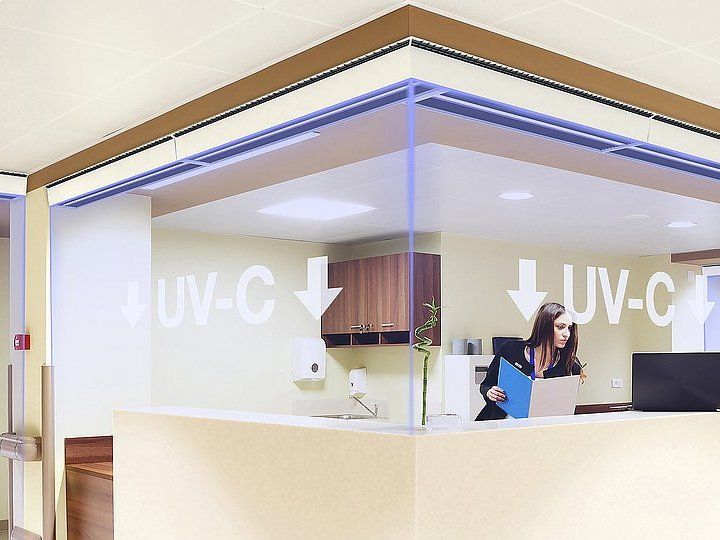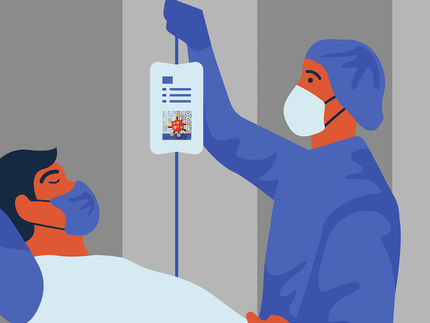Invisible virus protection for indoor spaces
Room divider based on UV-C light invisibly inactivates SARS-CoV-2 aerosols
Despite myriad precautionary measures, virus-contaminated aerosols still pose a serious problem indoors. An invisible protective wall of UV-C light developed by researchers at the Technical University of Munich (TUM) and the Division of Infectious Diseases and Tropical Medicine at the LMU University Hospital Munich could provide a solution and reliably curb the spread of viruses and other pathogens in rooms in the future while allowing total freedom of movement.

UV-C light extricates aerosols from pathogens such as the SARS-CoV-2 virus. This creates an invisible virus protection wall that protects the people behind it without restricting people's freedom of movement. An automatic shut-off device protects people passing through from UV radiation.
iStockphoto V I Levi; Modifikation: Smart United GmbH
A research team from the Technical University of Munich and the Division of Infectious Diseases and Tropical Medicine at the LMU University Hospital Munich, in cooperation with the start-up Smart United GmbH, has developed an invisible protective “wall” made of UV-C light.
In their study, published as a preprint on medRxiv, the researchers were able to demonstrate that the UV-C virus barrier they developed can prevent the spread of airborne pathogens indoors by killing the pathogens traveling along on the aerosol particles.
The protection rate was verified using model organisms, including E. coli, S. aureus, and a coronavirus. Inactivation rates of over 99 percent were achieved at air velocities of 10 cm/s.
Twofold protection system eliminates over 99 percent of pathogens
"Our system can be suspended from the ceiling like a lamp to subdivide rooms. The UV-C light radiates downward in a focused manner. As with a protective curtain, pathogens are inactivated as soon as they "float through" the barrier while piggybacking on aerosol particles," explains private lecturer Dr. med. Andreas Wieser, a specialist in microbiology, virology and infectious disease epidemiology at the Division of Infectious Diseases and Tropical Medicine at the LMU University Hospital Munich.
Professor Christoph Haisch from the Department of Analytical Chemistry and Water Chemistry at the Technical University of Munich adds: "In addition, the system with its patented protective mechanism disinfects breathing air in the room by drawing it in and slowly blowing it into the light-exposed area of the UV-C light wall. This, in combination with the direct barrier effect of the light wall, effectively prevents the accumulation of infectious aerosols in the room."
Safe virus dispersion suppression for small and large areas
Special shut-off devices ensure that the system's UV-C light poses no health risks. As soon as an object or body part enters the radiated area, the source is automatically switched off. This also applies when people pass through the light curtain, allowing total freedom of movement.
Applicable requirements for occupational health and safety, including the strict exposure limits for UV radiation specified and other legal requirements, are fulfilled thanks to innovative specialized optics. In addition, the innovative LED light source and the special optics prevent ozone formation.
The UV-C virus barrier can be used as an invisible room divider to segment large rooms into smaller "virtual" air-insulated rooms. This allows the system to be deployed as an essential part of aerosol hygiene concepts in rooms and buildings.
"We are currently doing everything imaginable to bring our virus protection walls to market as quickly as possible," says Reiner Prohaska, Managing Director of the cooperation partner Smart United. "Alongside the scientific validation of the system, we have started preparing production with well-known suppliers in the automotive industry. Starting in early January, we will commence space planning with our first customers. In April, we will deliver the first UV-C light virus protection walls – with the goal of returning a piece of normality to people’s lives."
Original publication
Something is happening in the life science industry ...
This is what true pioneering spirit looks like: Plenty of innovative start-ups are bringing fresh ideas, lifeblood and entrepreneurial spirit to change tomorrow's world for the better. Immerse yourself in the world of these young companies and take the opportunity to get in touch with the founders.




















































